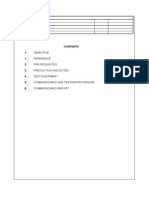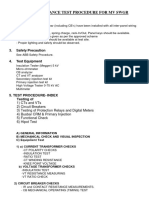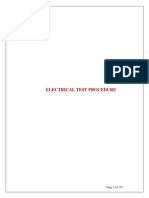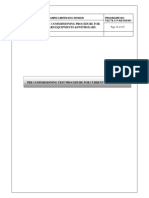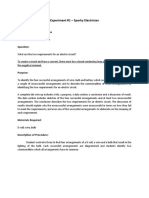Switchgear Inspection and Test Procedure: MV Systems
Uploaded by
ramadani bimaSwitchgear Inspection and Test Procedure: MV Systems
Uploaded by
ramadani bimaMV SYSTEMS
SWITCHGEAR INSPECTION AND TEST PROCEDURE
TABLE OF CONTENTS
1) VISUAL INSPECTION
2) WIRING AND FERRULING CHECK
3) BUS CONTINUITY, PHASING AND CONTACT RESISTANCE TEST
4) CURRENT TRANSFORMER CHECKS
5.1 Visual Inspection
5.2 Insulation resistance test
5.3 Winding resistance measurement
5.4 Polarity test
5.5 Ratio test by current primary injection
5.6 Magnetizing current test (minimum 2 points above )
5.7 Loop resistance measurement test (burden test)
5.8 Phase identification test
5.9 Verify secondary circuits, terminals, shorting/isolating links by primary injection
5.10 High voltage test.
5.11 Single point earthing check
5.12 Demagnetize CT cores after all tests
5) VOLTAGE TRANSFORMER CHECKS
6.1 Winding resistance test
6.2 Insulation resistance test HV/LV/G
6.3 Ratio test
6.4 Polarity test
6.5 Check VT HV neutral solidly grounded
6.6 Verify secondary circuits, terminal to terminal for correctness and tightness
6.7 Loop resistance test and burden test
6) CIRCUIT BREAKER CHECKS
7.1 Visual inspections.
7.2 Contact resistance measurements.
7.3 High- Pot and insulation resistance Test.
7.4 Functional check of trip free and anti pump circuits.
7.5 Functional checks of breaker operation counter.
7.6 Check correct operation of all auxiliary contacts (for breaker open/closed positions).
7.7 Timing test using an electronic oscillograph.
7.8 Check the correct functioning of interlocks and limits switches.
7) TESTING OF METERING ACCURACY BY SECONDARY INJECTION
8.1 Ammeter check
8.2 Voltmeter check
8.3 KWH meter check.
8.4 KW meter check.
8.5 Current transducer check
8.6 Voltage transducer check
8.7 KW transducer check
Page No. 1 of 20 Prepared by: RamadanCLASSIFICATION:
Mohamed NaguibCONFIDENTIAL MVTC-SG-ITP
MV SYSTEMS
MV SWITCHGEAR INSPECTION AND TEST PROCEDURE
8) TEST OF PROTECTION RELAYS BY SECONDARY INJECTION.
9.1 Over Current Relay
9.2 Earth Fault Relay
9.3 Under Voltage Protection Relay
9.4 Neutral Over Voltage Protection Relay
9.5 Trip Circuit Supervision Relay
9.6 Tripping Relay
9) PRIMARY CURRENT INJECTION TEST
10) HIGH- POT AND INSULATION RESISTANCE TEST
11) FUNCTIONAL CHECK
1. VISUAL INSPECTION
Page No. 2 of 20 Prepared by: RamadanCLASSIFICATION:
Mohamed NaguibCONFIDENTIAL MVTC-SG-ITP
MV SYSTEMS
MV SWITCHGEAR INSPECTION AND TEST PROCEDURE
1.1 Check nameplate information for correctness.
1.2 Inspect enclosures for proper alignment, foundation fixing and grounding.
1.3 Inspect all covers, panels section and doors for paint work and proper fit.
1.4 Check for smooth and proper movement of racking mechanisms for alignment, shutters, rollers, rails
and guides.
1.5 Check for proper alignment of the breaker primary and secondary contacts.
1.6 Check operation of all mechanical interlocks.
1.7 Check tightness of all bolted connections (torque wrench method).
1.8 Check bus and supports for defects such as cracked welds, chipped porcelain, cracked insulation, etc.,
and free of dust accumulation.
1.9 Verify that all front panel mounted devices (meters, push buttons, switches, indicator lamps, mimic
buses, etc.) are installed as per drawings
1.10 Perform mechanical check and visual inspection on all circuit breakers.
1.11 Perform mechanical check and visual inspection on all current transformers.
1.12 Perform mechanical check and visual inspection on all voltage transformers.
1.13 Perform mechanical check and visual inspection on all disconnected and grounding switches.
1.14 Check for correct breaker position indication.
1.15 Check for correct spring status indication (spring charged/discharged).
1.16 Perform all specific checks on the breaker and spring operating mechanism.
1.17 Check that all control wiring is correct according to the approved drawing and terminal connections are
secure.
2. WIRING AND FERRULING CHECK
2.1 Ensure the numbers on the ferrules are from left to right beginning at the terminal block i.e. a t the end
of the wire and from bottom to top.
2.2 The wire nos. should be checked against the wiring table and the schematic drawing.
3. BUS CONTINUITY, PHASING AND CONTACT RESISTANCE TEST
3.1. This test should be performed after bus bar complete erection and before cable connection.
3.2. Check the continuity for each phase and phasing.
3.3. Check the resistance for all bus bar joint using micro-ohm meter 100 A.
3.4. The main circuit resistance test shall be performed by100 Ampere DC by micro-ohmmeter from panel to
panel on each phase from cable spouts with all circuit breakers racked in service and on position.
3.5. For judgment, the resistance values from panel to panel should not vary too much if the number of joints
and length of bus bar remains the same.
4. CURRENT TRANSFORMER CHECKS
5.1. Visual Inspection
Page No. 3 of 20 Prepared by: RamadanCLASSIFICATION:
Mohamed NaguibCONFIDENTIAL MVTC-SG-ITP
MV SYSTEMS
MV SWITCHGEAR INSPECTION AND TEST PROCEDURE
♦ Inspect for physical damage / defects
♦ Check nameplate information for correctness
♦ Check that all grounding cables are securely connected
♦ Check color coded for secondary wiring and size of wires against specs.
♦ Check proper lugs has been used in termination
♦ Check CT’s location physically and secondary terminal labeling printed
5.2. Insulation Resistance Test
♦ The insulation resistance shall be checked at the terminals with respect to ground / earth with a 1KV
DC Voltage for One minute.
P1
S1
MEGGER
S2
P2
INSULATION TEST ARRANGEMENT
5.3. Winding Resistance Measurement
♦ Take CT Resistance measurements at the CT Terminals or at the Terminal Blocks in the LV
compartment using a Micro-ohm meter.
P1
S1
MILIOHMMETER
S2
P2
CT RESISTANCE MEASURING ARRANGEMENT
5.4. Polarity Test
♦ Check the CT polarities on the Terminals as per the Schematic Drawing in the LV -compartment for
correct polarity.
Page No. 4 of 20 Prepared by: RamadanCLASSIFICATION:
Mohamed NaguibCONFIDENTIAL MVTC-SG-ITP
MV SYSTEMS
MV SWITCHGEAR INSPECTION AND TEST PROCEDURE
P1
S1
+
SENSITIVE
SWITCH
AMMETER A
S2
-
+
BATTERY
-
P2
CT POLARITY TEST ARRANGEMENT
5.5. Ratio Test By Current Primary Injection
♦ Check the CT ratio by injecting 25%, 50%, 75%, & 100% (if possible) of the normal current on the CT
primary winding and measure the corresponding secondary winding current.
P1
S1
AMMETER A
PRIMARY S2
INJECTION
TEST SET
P2
CT RATIO TEST ARRANGEMENT
5.6. Magnetizing Current Test (Minimum 2 Points Above )
♦ Check the Magnetization Curves by applying gradually increasing voltage to the CT Secondary and
noting the magnetization currents.
♦ Apply the potential at the Terminal Block.
♦ The Readings are entered in the form and the program will automatically print the curves.
♦ The purpose of this test is to ensure that the Knee Point Voltage is correct and most important to
ensure the protections and instrumentations are connected to the relevant cores.
♦ The knee point is the point on the magnetization curve at witch 10 % increase in excitation voltage
produces 50 % increase in excitation current.
♦ Minimum two points over the knee point shall be taken.
Page No. 5 of 20 Prepared by: RamadanCLASSIFICATION:
Mohamed NaguibCONFIDENTIAL MVTC-SG-ITP
MV SYSTEMS
MV SWITCHGEAR INSPECTION AND TEST PROCEDURE
P1
STEP UP
VARIAC TRANSFORMER S1
A
AC SUPPLY V
S2
P2
PLOTTING OF THE MAGNETIZATIOM CURVE
ARRANGEMENT
5.7. Loop Resistance Measurement Test (Burden Test)
♦ Check the CT Loop Resistance with a Micro-ohm-meter at the extreme end terminals to ensure the
complete loop.
P1
P1
S1
S1
RELAY
S2
RELAY V
S2
A
MILIOHMMETER
CURRENT
SOURCE
P2 P2
LOOP RESISTANCE MEASURING ARRANGEMENT BURDEN TEST ARRANGEMENT
5.8. Phase Identification Test
• Check Phase identification test by injecting single-phase primary current.
• Check the secondary current in all phases.
• The secondary current should be zero in all phases except the one we injecting current on.
5.9. Verify Secondary Circuits, Terminals, Shorting/Isolating Links By Primary Injection
Page No. 6 of 20 Prepared by: RamadanCLASSIFICATION:
Mohamed NaguibCONFIDENTIAL MVTC-SG-ITP
MV SYSTEMS
MV SWITCHGEAR INSPECTION AND TEST PROCEDURE
• After primary injection test and with the same arrangement check that the secondary circuit CT
terminal shorting / isolation is actually working by closing the shorting link / open the slide link
and check the current.
5.10. High Voltage Test
• During normal HV tests on switchgear or GIS, the CT’s are included in the HV test.
• Shorted the CT’s secondary to ground and isolated from relays and meters.
5.11. Single Point Earthing Check
• It is imperative to ensure that only one end of the CT Secondary is earthed, especially where
CT’s are paralleled.
5.12. Demagnetize CT Cores After All Tests
• After performing all the mentioned tests for the CT, apply voltage greater than the knee point
voltage gradually to the CT secondary winding.
• Go back gradually to zero voltage.
6. VOLTAGE TRANSFORMER CHECKS
6.1 Visual Inspection
♦ Inspect for physical damage / defects
♦ Check nameplate information for correctness
♦ Check that all grounding cables are securely connected
♦ Check color coded for secondary wiring and size of wires against specs.
♦ Check proper lugs has been used in termination
♦ Check VT’s location physically and secondary terminal labeling printed
6.2 Winding Resistance Test
♦ Check the VT Resistance at the VT terminals or at the Terminal Blocks in the LV compartment using a
Micro-ohm-meter.
A
a1
MILIOHM
METER
n1
a2
N
n2
VT RESISTANCE TESTING
ARRANGEMENT
6.3 Insulation Test
• Check the insulation resistance at the terminals with respect to ground / earth.
• The test voltage is 1 KV DC for one minute.
Page No. 7 of 20 Prepared by: RamadanCLASSIFICATION:
Mohamed NaguibCONFIDENTIAL MVTC-SG-ITP
MV SYSTEMS
MV SWITCHGEAR INSPECTION AND TEST PROCEDURE
A
a1
MEGGER
n1
a2
N
n2
INSULATION TESTING ARRANGEMENT
6.4 Ratio Check
• Apply one, 2 & 3 KV on VT primary terminal.
• Measure the corresponding out put on VT secondary terminal.
• Calculate VT turns ratio.
A
a1 STEP UP
TRANSFORMER VARIAC
V
SUPPLY
n1
AC
a2
V
N
n2
VT RATIO TESTING ARRANGEMENT
6.5 VT Polarity Checks
• Check the VT polarities on the LV compartment terminals as per the Schematic Drawing for
correct polarity.
A
a1
+
SWITCH A
- n1
+
BATTERY a2
-
N
n2
VT POLARITY TESTING ARRANGEMENT
6.5 Check VT HV Neutral Solidly Grounded
6.6 Verify Secondary Circuits, Terminal To Terminal For Correctness And Tightness
6.7 Loop Resistance Test And Burden Test
Page No. 8 of 20 Prepared by: RamadanCLASSIFICATION:
Mohamed NaguibCONFIDENTIAL MVTC-SG-ITP
MV SYSTEMS
MV SWITCHGEAR INSPECTION AND TEST PROCEDURE
• Check the VT Loop Resistance with an ohmmeter at the extreme end terminals to ensure the
complete loop.
S1
S1
RELAY
RELAY V
S2
S2
A
OHMMETER
VOLTAGE
SOURCE
LOOP RESISTANCE MEASURING ARRANGEMENT BURDEN TEST ARRANGEMENT
7 CIRCUIT BREAKER CHECKS
7.1 Visual Inspections.
• Check nameplate information for correctness.
• Check tightness of all bolted connections (torque wrench method).
• Check all wiring is correct according to approved drawings terminal connections are secured.
• Check quality of paintwork.
• Check that all grounding cables are securely connected.
• Check breakers, truck, rails, for proper alignment and smooth movement.
• Check operation of all mechanical interlocks with associated disconnects, grounding switches,
racking truck mechanism, cubicle doors, etc.
• Check for correct breaker position indication (breaker open/closed).
• Check manual spring charge operation.
• Verify correct spring status indication (spring charge d/discharged).
• Verify that correct Dispatch Numbers have been installed.
7.2 Contact Resistance Measurements.
• Close the CB.
• The micro ohmmeter test is conducted with a current of 100 ADC.
• Connect the test set to the first phase of the CB.
• Record the reading.
Page No. 9 of 20 Prepared by: RamadanCLASSIFICATION:
Mohamed NaguibCONFIDENTIAL MVTC-SG-ITP
MV SYSTEMS
MV SWITCHGEAR INSPECTION AND TEST PROCEDURE
• Repeat it for all CB phases.
CB MAIN CONTACTS
MICRO OHM
METER R Y B
CB CONTACT RESISTANCE TESTING ARRANGEMENT
7.3 High- Pot Test and insulation Resistance test.
7.3.1 Insulation Resistance Test At 5kv DC.
At the CB Closed
• Connect the phases Y, B to ground and apply the test voltage between phase R and
ground.
• Connect the phases B, R to ground and apply the test voltage between phase Y and
ground.
• Connect the phases R, Y to ground and apply the test voltage between phase B and
ground.
• Record the corresponding Insulation Resistance readings.
At the CB Open
• Connect the phases R, Y, B Cable side to the ground.
• Connect the phases R, Y, B Bus side to the test set.
• Record the corresponding Insulation Resistance readings.
7.3.2 High-Pot Test
♦ AC high- pot test shall be carried out in accordance with IEC standard at site.
♦ The test will carry out at test voltage 38 KV fore 60 second.
♦ If the test have been done at factory at 38 kV it will be done at site at 80% of the last time.
At the CB Closed
• Connect the phases Y, B to ground and apply the test voltage between phase R and
ground.
• Connect the phases B, R to ground and apply the test voltage between phase Y and
ground.
• Connect the phases R, Y to ground and apply the test voltage between phase B and
ground.
• Record the corresponding leakage current readings.
At the CB Open
• Connect the phases R, Y, B Cable side to the ground.
• Connect the phases R, Y, B Bus side to the test set.
• Record the corresponding leakage current readings.
Page No. 10 of 20 Prepared by: RamadanCLASSIFICATION:
Mohamed NaguibCONFIDENTIAL MVTC-SG-ITP
MV SYSTEMS
MV SWITCHGEAR INSPECTION AND TEST PROCEDURE
CB MAIN CONTACTS CB MAIN CONTACTS
HIGH POT HIGH POT
TESTER R Y B TESTER R Y B
AC WITHSTAND VOLTAGE TESTING ARRANGEMENT AC WITHSTAND VOLTAGE TESTING ARRANGEMENT
7.3.3 Insulation Resistance Test Of All Low Voltage Wiring And Cabling At 500 V DC.
• Connect all the wires together (+ve and –ve) or (L and N) and apply the test voltage between
the wires and ground.
• Record the corresponding Insulation Resistance readings
7.4 Functional Check Of Trip Free And Anti Pump Circuits.
♦ The Anti- Pump feature in the Breakers were tested as follows:
♦ The Breaker was closed and the control switch was held in close position.
♦ It was ensured that the breaker closes
♦ The Breaker was tripped as below while the control switch was held in Close position: A: Manually
B: Electrically
♦ It will be noted from the results that the Breaker does not attempt to re-close if a permanents
closing signal is applied.
7.5 Functional Checks Of Breaker Operation Counter.
7.6 Check Correct Operation Of All Auxiliary Contacts (For Breaker Open/Closed Positions).
7.7 Timing Test Using An Electronic Oscillograph.
• Connect the test set to the CB.
• Perform the following operations at the rated DCV.
• Close ( C ) , Open ( O ) , Close - Open ( C – O ) & Open – Close – Open ( O – C – O )
• Record the corresponding readings.
Page No. 11 of 20 Prepared by: RamadanCLASSIFICATION:
Mohamed NaguibCONFIDENTIAL MVTC-SG-ITP
MV SYSTEMS
MV SWITCHGEAR INSPECTION AND TEST PROCEDURE
CB MAIN CONTACTS
CH. 1
R Y B
CH. 2
CH. 3
CLOSING
CB CLOSING TERMINALS
ORDER
TRIPPING
CB TRIPPING TERMINALS
ORDER
DC SUPPLY +
CB TIMING TEST ARRANGEMENT
7.8 Check The Correct Functioning Of Interlocks And Limits Switches.
8. TESTING OF METERING ACCURACY BY SECONDARY INJECTION
Metering calibration shall be tested via front panel mounted test facilities.
Maximum demand indicator (MDI) meters shall be tested at 10% and 100% of full scale.
Current and voltage metering and transducers calibration shall be tested at 0, 25, 50, 100% of scale.
Watt and VAR metering and transducers calibration shall be tested at (+/- when bi-directional) 0, 25, 50,100% of rated
load and with rated voltage and current at angles of 0, 45,180, 225, 270 and 315 degrees.
KWH and KVARH metering calibration shall be tested at 10% and 100% of rated current at angles of 0, 45, 90, 180,
225, 270 and 315 degrees.
Power Factor metering and transducers calibration shall be tested at rated voltage and at 50% lead, unit y, 50% lag
power factors at 10, 50, 100% rated current.
8.1. Ammeter Check
• Connect the current test set on the ammeter terminals.
• Inject 25, 50 & 100 % of the full-scale current of the ammeter.
• Record the corresponding ammeter readings.
• Inject 100 % of the normal current.
• Record corresponding ammeter reading.
RELAY TEST SET
TERMINALS
CURRENT
N
A
AMMETER TESTING ARRANGEMENT
8.2. Voltmeter Check
• Connect the voltage test set on the voltmeter terminals.
• Apply 25, 50 & 100 % of the full-scale voltage of the voltmeter.
Page No. 12 of 20 Prepared by: RamadanCLASSIFICATION:
Mohamed NaguibCONFIDENTIAL MVTC-SG-ITP
MV SYSTEMS
MV SWITCHGEAR INSPECTION AND TEST PROCEDURE
• Record the corresponding voltmeter readings.
• Apply 100 % of the normal voltage.
• Record corresponding voltmeter reading.
RELAY TEST SET
TERMINALS
VOLTAGE
R
N
V
VOLTMETER TESTING ARRANGEMENT
8.3. Energy Meter Check
♦ Connect the current test set terminals to the Energy meter current terminals.
♦ Connect the voltage test set terminals to the Energy meter voltage terminals.
♦ Apply 0, 25, 50,100% of rated load and with rated voltage and current at angles of
♦ 0, 45,180, 225, 270 and 315 degrees for time.
♦ Record the corresponding Energy meter readings.
RELAY TEST SET TEST PLUG KWH METER
R R
TERMINALS
CURRENT
TERMINALS
CURRENT
Y Y
B B
N N
R R
TERMINALS
TERMINALS
VOLTAGE
VOLTAGE
Y Y
B B
N N
KWH METER TESTING ARRANGEMENT
8.4. Power Meter Check
• Connect the current test set terminals to the Power meter current terminals.
• Connect the voltage test set terminals to the Power meter voltage terminals.
• Apply 0, 25, 50,100% of rated load with rated voltage and current at angles of 0, 45,180, 225, 270
and 315 degrees.
• Record the corresponding Power meter readings.
RELAY TEST SET TEST PLUG KW METER
R R
TERMINAL
CURRENT
TERMINAL
CURRENT
Y Y
S
S
B B
N N
R R
TERMINAL
VOLTAGE
TERMINAL
VOLTAGE
Y Y
S
S
B B
N N
KW METER TESTING ARRANGEMENT
8.5. Current Transducer Check
• Connect the current test set on the Current Transducer terminals.
Page No. 13 of 20 Prepared by: RamadanCLASSIFICATION:
Mohamed NaguibCONFIDENTIAL MVTC-SG-ITP
MV SYSTEMS
MV SWITCHGEAR INSPECTION AND TEST PROCEDURE
• Inject 25, 50 & 100 % of the full-scale current of the Current Transducer.
• Record the corresponding Current Transducer out put.
• Inject 100 % of the rated current.
• Record corresponding Current Transducer out put.
CURRENT
RELAY TEST SET
TRANSDUCER
TERMINALS
TERMINALS
CURRENT
R
INPUT
N
TERMINALS
OUTPUT
A
CURRENT TRANSDUCER TESTING ARRANGEMENT
8.6. Voltage Transducer Check
• Connect the Voltage test set on the Voltage Transducer terminals.
• Inject 25, 50 & 100 % of the full-scale Voltage of the Voltage Transducer.
• Record the corresponding Voltage Transducer out put.
• Inject 100 % of the rated Voltage.
• Record corresponding Voltage Transducer out put.
VOLTAGE
RELAY TEST SET
TRANSDUCER
TERMINALS
TERMINALS
VOLTAGE
R
INPUT
N
TERMINALS
OUTPUT
VOLTAGE TRANSDUCER TESTING ARRANGEMENT
8.7. Power Transducer
• Connect the current test set terminals to the Power Transducer current terminals.
• Connect the voltage test set terminals to the Power Transducer voltage terminals.
• Apply 0, 25, 50,100% of rated load with rated voltage and current at angles of 0, 45,180, 225, 270
and 315 degrees.
• Record the corresponding Power Transducer O/P readings.
Power
RELAY TEST SET TEST PLUG
Transducer
R R
TERMINAL
CURRENT
TERMINAL
CURRENT
Y Y
S
S
B B
N N
R R
TERMINAL
VOLTAGE
TERMINAL
VOLTAGE
Y Y
S
S
B B
N N
Power Transducer TESTING ARRANGEMENT
Page No. 14 of 20 Prepared by: RamadanCLASSIFICATION:
Mohamed NaguibCONFIDENTIAL MVTC-SG-ITP
MV SYSTEMS
MV SWITCHGEAR INSPECTION AND TEST PROCEDURE
9. Test Of Protection Relays By Secondary Injection.
Notes:
1. Testing Engineer should provide the commissioning manuals and have the detailed understanding for
testing and commissioning procedure.
2. All outputs / indications to be tested.
3. Initial tests of new protective relays must include operating characteristics checks for a
representative range of available settings with Company approved computer operated test
equipment running routines developed for the specific relay and test set involved.
4. Relay auxiliary devices such as external resistors, metrosils, etc. to be tested to conform to required
ratings and manufacturer’s information.
5. Final calibration test of all protective relays must be carried out on approved settings, by secondary
injection at the front panel mounted test facilities.
6. Auxiliary and tripping relay testing shall include,
7. Pickup and dropout voltage, verification of all contacts.
8. Operation timing at 80% and 100% nominal voltage.
9. Time delay relays shall be tested at 0%, set point and 100% delay.
10. Use of red and green tags for tested relays, meters, etc.
11. All the relays and meters which have been tested and found o.k must have green tags
12. The relays and meters found defective during tests should be tagged red.
9.1 Over Current Relay
9.1.1. Over Current Pick-Up
♦ Apply the testing relays setting for over current on the relay as following.
o Definite Time Curve with minimum time delay.
o Disable All other protection elements.
♦ Connect the current test set on the relay current terminals one at a time as following.
o Red phase to Neutral.
o Yellow phase to Neutral.
o Blue phase to neutral.
♦ Connect the timer to the relay tripping contact
♦ Slowly increase the current until the relay picked-up.
♦ Record the operating current.
9.1.2. Operating Time Verification
♦ Apply the testing relays setting for over current on the relay as following.
o Disable all other protection elements.
o DT curve with 500ms delay.
o IEC SI curve with 0.1 TMS.
o IEC VI curve with 0.1 TMS.
o IEC EI curve with 0.1 TMS.
o IEC STI curve with 0.1 TMS.
♦ Select the time over current curve one at a time on the relay.
♦ Connect the current test set on the relay current terminals one at a time as following.
o Red phase to Neutral.
o Yellow phase to Neutral.
o Blue phase to neutral.
♦ Connect the timer to the relay tripping contact
♦ Inject testing current and monitor the operating time of the relay.
♦ Record the operating time.
Page No. 15 of 20 Prepared by: RamadanCLASSIFICATION:
Mohamed NaguibCONFIDENTIAL MVTC-SG-ITP
MV SYSTEMS
MV SWITCHGEAR INSPECTION AND TEST PROCEDURE
9.1.3. Instantaneous Unit Verification
♦ Apply the testing relays setting for over current on the relay as following.
o Disable all other protection elements.
♦ Connect the current test set on the relay current terminals one at a time as following.
o Red phase to Neutral.
o Yellow phase to Neutral.
o Blue phase to neutral.
♦ Connect the timer to the relay tripping contact.
♦ Slowly increase the current until the pick-up indication operates.
♦ Record the operating current.
RELAY TEST SET TEST PLUG OC & EF RELAY
R R
TERMINALS
CURRANT
TERMINALS
CURRANT
Y Y
B B
N N
CONTACT
TIMER
TRIP
OVER CURRENT AND EARTH FAULT RELAY TESTING ARRANGEMENT
9.2 Earth Fault Relay
9.2.1. Earth Fault Pick-Up
♦ Apply the testing relays setting for Earth Fault on the relay as following.
o Definite Time Curve with minimum time delay.
o Disable All other protection elements.
♦ Connect the current test set on the relay current terminals one at a time as following.
o Any phase to Neutral.
♦ Slowly increase the current until the pick-up indication operates.
♦ Record the operating current.
9.2.2. Operating Time Verification
♦ Apply the testing relays setting for Earth Fault on the relay as following.
o Disable all other protection elements.
o DT curve with 500ms delay.
o IEC SI curve with 0.1 TMS.
o IEC VI curve with 0.1 TMS.
o IEC EI curve with 0.1 TMS.
o IEC STI curve with 0.1 TMS.
♦ Select the time Earth Fault curve one at a time on the relay.
♦ Connect the current test set on the relay current terminals one at a time as following.
o Any phase to Neutral.
♦ Connect the timer to the relay tripping contact
♦ Inject testing current and monitor the operating time of the relay.
♦ Record the operating time.
9.2.3. Instantaneous Unit Verification
♦ Apply the testing relays setting for Earth Fault on the relay as following.
o Disable all other protection elements.
Page No. 16 of 20 Prepared by: RamadanCLASSIFICATION:
Mohamed NaguibCONFIDENTIAL MVTC-SG-ITP
MV SYSTEMS
MV SWITCHGEAR INSPECTION AND TEST PROCEDURE
♦ Connect the current test set on the relay current terminals one at a time as following.
o Any phase to Neutral.
♦ Connect the timer to the relay tripping contact.
♦ Slowly increase the current until the pick-up indication operates.
♦ Record the operating current.
RELAY TEST SET TEST PLUG OC & EF RELAY
R R
TERMINALS
CURRANT
TERMINALS
CURRANT
Y Y
B B
N N
CONTACT
TIMER
TRIP
OVER CURRENT AND EARTH FAULT RELAY TESTING ARRANGEMENT
9.3 Under Voltage Protection Relay
9.3.1. Under Voltage Verification
♦ Apply the testing relays setting with instantaneous tripping time on the relay
♦ Connect the voltage test set on the relay voltage terminals
♦ Connect the timer to the relay tripping contact
♦ Slowly Decrease the applied voltage until the relay pick-up
♦ Record the pick-up voltage
9.3.2. Delay Time Verification
♦ Select the operating time on the relay
♦ Connect the voltage test set on the relay voltage terminals
♦ Connect the timer to the relay tripping contact
♦ Apply the testing voltage and monitor the operating time of the relay
♦ Record the operating time.
RES. VOLTAGE
RELAY TEST SET TEST PLUG
E/F RELAY
TERMINALS
VOLTAGE
R
TERMINALS
VOLTAGE
N
CONTACT
TIMER
TRIP
RESIDUAL VOLTAGE E/F RELAY TESTING ARRANGEMENT
9.4 Neutral Over Voltage Protection Relay
9.4.1 Neutral Over Voltage Verification
♦ Apply the testing relays setting with instantaneous tripping time on the relay
♦ Connect the voltage test set on the relay terminals
♦ Connect the timer to the relay tripping contact
♦ Slowly increase the applied voltage until the relay pick-up
♦ Record the pick-up voltage
9.4.2 Delay Time Verification
♦ Select the operating time on the relay
Page No. 17 of 20 Prepared by: RamadanCLASSIFICATION:
Mohamed NaguibCONFIDENTIAL MVTC-SG-ITP
MV SYSTEMS
MV SWITCHGEAR INSPECTION AND TEST PROCEDURE
♦ Connect the voltage test set on the relay voltage terminals
♦ Connect the timer to the relay tripping contact
♦ Apply the testing voltage and monitor the operating time of the relay
♦ Record the operating time.
9.5 Trip Circuit Supervision Relay
9.5.1 Voltage Pick-Up Verification
♦ Slowly increase the voltage until the relay pick-up
♦ Record the pick-up voltage.
9.5.2 Voltage Drop-Out Verification
♦ Slowly increase the voltage until the relay pick-up
♦ While relay is still picking-up slowly reduce the voltage until the relay dropout.
♦ Record the dropout voltage.
9.5.3 Function Check
♦ All the internal and external wiring should be completed
9.5.3.1 The CB Is In Open Position
• At the CB control panel / box open tripping coils circuit one by one
• The trip circuit supervision relay should operate in each time
9.5.3.1 The CB In Close Position
♦ At the CB control panel / box open tripping coils circuit one by one
♦ The trip circuit supervision relay should operate in each time
RELAY TEST SET TEST PLUG TCS RELAY
DC VOLTAGE
TERMINALS
TERMINALS
+
+
COIL
-
-
CONTACT
TIMER
RELAY
TRIP CIRCUIT SUPERVISION RELAY TESTING ARRANGEMENT
9.6 Tripping Relay
9.6.1 Voltage Pick-Up Verification
♦ Connect the voltage test set on the relay voltage terminals
♦ Connect the timer to the relay tripping contact
♦ Slowly increase the voltage until the relay pick-up
♦ Record the pick-up voltage
9.6.2 Voltage Drop-Out Verification
♦ Connect the voltage test set on the relay voltage terminals
♦ Connect the timer to the relay tripping contact
♦ Slowly increase the voltage until the relay pick-up
♦ While relay is still picking-up slowly reduce the voltage until the relay dropout
♦ Record the dropout voltage
Page No. 18 of 20 Prepared by: RamadanCLASSIFICATION:
Mohamed NaguibCONFIDENTIAL MVTC-SG-ITP
MV SYSTEMS
MV SWITCHGEAR INSPECTION AND TEST PROCEDURE
9.6.2.1 Delay Time Verification
♦ Connect the voltage test set on the relay voltage terminals
♦ Connect the timer to the relay tripping contact
♦ Apply the testing voltage and monitor the operating time of the relay
♦ Record the operating time.
TRIPPING
RELAY TEST SET TEST PLUG
RELAY
DC VOLTAGE
TERMINALS
TERMINALS
+
+
COIL
-
-
CONTACT
TIMER
TRIP
TRIPPING RELAY TESTING ARRANGEMENT
10 PRIMARY CURRENT INJECTION TEST
• As per Current transformers scheme
11 HIGH- POT AND INSULATION RESISTANCE TEST
11.1 Insulation Resistance Test At 5kv DC.
At the CBs in Service and Closed
• Connect the phases Y, B to ground and apply the test voltage between phase R and
ground.
• Connect the phases B, R to ground and apply the test voltage between phase Y and
ground.
• Connect the phases R, Y to ground and apply the test voltage between phase B and
ground.
• Record the corresponding Insulation Resistance readings.
At the CBs in Service and Open
• Connect the phases R, Y, B Cable side to the ground.
• Connect the phases R, Y, B Bus side to the test set.
• Record the corresponding Insulation Resistance readings.
11.2 High-Pot Test
♦ AC high- pot test shall be carried out in accordance with IEC standard at site.
♦ The test will carry out at test voltage 38 KV fore 60 second.
♦ If the test have been done at factory at 38 kV it will be done at site at 80% of the last time.
♦ At the CBs in Service and Closed
• Connect the phases Y, B to ground and apply the test voltage between phase R and
ground.
• Connect the phases B, R to ground and apply the test voltage between phase Y and
ground.
• Connect the phases R, Y to ground and apply the test voltage between phase B and
ground.
Page No. 19 of 20 Prepared by: RamadanCLASSIFICATION:
Mohamed NaguibCONFIDENTIAL MVTC-SG-ITP
MV SYSTEMS
MV SWITCHGEAR INSPECTION AND TEST PROCEDURE
• Record the corresponding leakage current readings.
♦ At the CBs in Service and Open
• Connect the phases R, Y, B Cable side to the ground.
• Connect the phases R, Y, B Bus side to the test set.
• Record the corresponding leakage current readings.
CB MAIN CONTACTS CB MAIN CONTACTS
HIGH POT HIGH POT
TESTER R Y B TESTER R Y B
AC WITHSTAND VOLTAGE TESTING ARRANGEMENT AC WITHSTAND VOLTAGE TESTING ARRANGEMENT
11.3 Insulation Resistance Test Of All Low Voltage Wiring And Cabling At 500 V DC.
• Connect all the wires together (+ve and –ve) or (L and N) and apply the test voltage between
the wires and ground.
• Record the corresponding Insulation Resistance readings
12 FUNCTIONAL CHECK
As per control scheme
Page No. 20 of 20 Prepared by: RamadanCLASSIFICATION:
Mohamed NaguibCONFIDENTIAL MVTC-SG-ITP
View publication stats
You might also like
- Pre Commissioning & Commissioning - Procedure & Test Reports - MV Switchgear71% (7)Pre Commissioning & Commissioning - Procedure & Test Reports - MV Switchgear123 pages
- Testing and Commissioning Procedures Swyd - 284% (25)Testing and Commissioning Procedures Swyd - 2223 pages
- Method Statement For MV Switchgear (Inspire)50% (4)Method Statement For MV Switchgear (Inspire)5 pages
- GIS Testing and Commissioning Checklist - SEC - CSD100% (2)GIS Testing and Commissioning Checklist - SEC - CSD4 pages
- Electrical Switchboard Test and Commissioning Procedure100% (4)Electrical Switchboard Test and Commissioning Procedure4 pages
- Method Statement For Testing & Commissioning of Central Battery SystemNo ratings yetMethod Statement For Testing & Commissioning of Central Battery System6 pages
- MV Switchgear Inspection and Test Procedure: October 2019100% (1)MV Switchgear Inspection and Test Procedure: October 201921 pages
- All Test Procedures (31121016-000-Gap-00023-000)100% (2)All Test Procedures (31121016-000-Gap-00023-000)155 pages
- 01-Pre-Commissioning Tests For SEC Transmission Electrical EquipmentsNo ratings yet01-Pre-Commissioning Tests For SEC Transmission Electrical Equipments38 pages
- MS For Testing and Commissioning of HV & LV Electrical Equipment90% (10)MS For Testing and Commissioning of HV & LV Electrical Equipment26 pages
- SP0407 Commissioning Tests For HV UG Cables100% (4)SP0407 Commissioning Tests For HV UG Cables13 pages
- Test and Inspection For Low Voltage Cubicle Switchboard100% (1)Test and Inspection For Low Voltage Cubicle Switchboard3 pages
- Factory Acceptance Test (FAT) Procedure of LV Switchboards100% (1)Factory Acceptance Test (FAT) Procedure of LV Switchboards13 pages
- Perform Pick Up Drop Off Test of Relay: Prepared By: B.R.PrajapatiNo ratings yetPerform Pick Up Drop Off Test of Relay: Prepared By: B.R.Prajapati4 pages
- Testing Procedures For HV Voltage Transformers100% (1)Testing Procedures For HV Voltage Transformers4 pages
- Commissioning Services Department Commissioning Manual Factory Type and Routine TestsNo ratings yetCommissioning Services Department Commissioning Manual Factory Type and Routine Tests19 pages
- Testing and Commissioning of MetalClad SwitchgearNo ratings yetTesting and Commissioning of MetalClad Switchgear3 pages
- ECS 11-0003 Testing and Commissioning Guidance NotesNo ratings yetECS 11-0003 Testing and Commissioning Guidance Notes48 pages
- 11KV - 415V Overhead Line Specification (REC) - Electrical Notes & ArticlesNo ratings yet11KV - 415V Overhead Line Specification (REC) - Electrical Notes & Articles43 pages
- Precommissioning Procedures of Testing Commissioning PDF67% (3)Precommissioning Procedures of Testing Commissioning PDF96 pages
- Pre-Commissioning TestsProcedure For SEC Transmission Electrical Installation88% (8)Pre-Commissioning TestsProcedure For SEC Transmission Electrical Installation222 pages
- SMS 05. Distribution Board - Rev.00 Y2023.02.10No ratings yetSMS 05. Distribution Board - Rev.00 Y2023.02.1021 pages
- Bus Bar Contact Resistance Measurement Test67% (6)Bus Bar Contact Resistance Measurement Test4 pages
- MV Switchgear CT Inspection and Test Procedure: October 2019100% (1)MV Switchgear CT Inspection and Test Procedure: October 20196 pages
- Tamco-Protection MV Switchgear Method StatementNo ratings yetTamco-Protection MV Switchgear Method Statement10 pages
- MSRA FOR TESTING AND COMMISSIONINGB OF MV SWITCHGEARNo ratings yetMSRA FOR TESTING AND COMMISSIONINGB OF MV SWITCHGEAR25 pages
- Adwea/addc/aadc Standard: Sat-Aaa-Swg-Mv - (Rev.0-2015)No ratings yetAdwea/addc/aadc Standard: Sat-Aaa-Swg-Mv - (Rev.0-2015)12 pages
- Konsorsium PT - Pgas Solution Pt. Patra Drilling Contractor Jasa Perancangan, Pengadaan Dan Konstruksi Penggantian Pipa Minyak Wilayah Kerja Rokan100% (1)Konsorsium PT - Pgas Solution Pt. Patra Drilling Contractor Jasa Perancangan, Pengadaan Dan Konstruksi Penggantian Pipa Minyak Wilayah Kerja Rokan2 pages
- Ground Fault Protection - Schneider KatalogNo ratings yetGround Fault Protection - Schneider Katalog144 pages
- Short Circuit Withstand of Power Cables A Calculation ExampleNo ratings yetShort Circuit Withstand of Power Cables A Calculation Example59 pages
- Simotics GP SD XP DP Catalogue D 81 1 en 2018 Halaman 11No ratings yetSimotics GP SD XP DP Catalogue D 81 1 en 2018 Halaman 111 page
- PDF Blockchain, Big Data and Machine Learning: Trends and Applications First Edition Kumar DownloadNo ratings yetPDF Blockchain, Big Data and Machine Learning: Trends and Applications First Edition Kumar Download53 pages
- MC33201, MC33202, MC33204, NCV33202, NCV33204 Low Voltage, Rail-to-Rail Operational AmplifiersNo ratings yetMC33201, MC33202, MC33204, NCV33202, NCV33204 Low Voltage, Rail-to-Rail Operational Amplifiers18 pages
- Advanced View of Atmega Microcontroller Projects List - Projects Tutorials Code Library For Atmels Atmega32 AVRNo ratings yetAdvanced View of Atmega Microcontroller Projects List - Projects Tutorials Code Library For Atmels Atmega32 AVR178 pages
- BA5018 - Unit II - Organizational DesignNo ratings yetBA5018 - Unit II - Organizational Design133 pages
- Everything Has Changed in iOS 14, But Jailbreak Is Eternal: Zuozhi Fan (@pattern - F - )No ratings yetEverything Has Changed in iOS 14, But Jailbreak Is Eternal: Zuozhi Fan (@pattern - F - )40 pages
- Resume 3 Modeling of Lithium-Ion Battery Using Simulink100% (1)Resume 3 Modeling of Lithium-Ion Battery Using Simulink30 pages
- Khan, 2023 - Review Design and Optimization of Lithium-Ion BatteryNo ratings yetKhan, 2023 - Review Design and Optimization of Lithium-Ion Battery33 pages
- Module 1 Science Technology and SocietyNo ratings yetModule 1 Science Technology and Society12 pages
- Pre Commissioning & Commissioning - Procedure & Test Reports - MV SwitchgearPre Commissioning & Commissioning - Procedure & Test Reports - MV Switchgear
- GIS Testing and Commissioning Checklist - SEC - CSDGIS Testing and Commissioning Checklist - SEC - CSD
- Electrical Switchboard Test and Commissioning ProcedureElectrical Switchboard Test and Commissioning Procedure
- Method Statement For Testing & Commissioning of Central Battery SystemMethod Statement For Testing & Commissioning of Central Battery System
- MV Switchgear Inspection and Test Procedure: October 2019MV Switchgear Inspection and Test Procedure: October 2019
- 01-Pre-Commissioning Tests For SEC Transmission Electrical Equipments01-Pre-Commissioning Tests For SEC Transmission Electrical Equipments
- MS For Testing and Commissioning of HV & LV Electrical EquipmentMS For Testing and Commissioning of HV & LV Electrical Equipment
- Test and Inspection For Low Voltage Cubicle SwitchboardTest and Inspection For Low Voltage Cubicle Switchboard
- Factory Acceptance Test (FAT) Procedure of LV SwitchboardsFactory Acceptance Test (FAT) Procedure of LV Switchboards
- Perform Pick Up Drop Off Test of Relay: Prepared By: B.R.PrajapatiPerform Pick Up Drop Off Test of Relay: Prepared By: B.R.Prajapati
- Commissioning Services Department Commissioning Manual Factory Type and Routine TestsCommissioning Services Department Commissioning Manual Factory Type and Routine Tests
- ECS 11-0003 Testing and Commissioning Guidance NotesECS 11-0003 Testing and Commissioning Guidance Notes
- 11KV - 415V Overhead Line Specification (REC) - Electrical Notes & Articles11KV - 415V Overhead Line Specification (REC) - Electrical Notes & Articles
- Precommissioning Procedures of Testing Commissioning PDFPrecommissioning Procedures of Testing Commissioning PDF
- Pre-Commissioning TestsProcedure For SEC Transmission Electrical InstallationPre-Commissioning TestsProcedure For SEC Transmission Electrical Installation
- MV Switchgear CT Inspection and Test Procedure: October 2019MV Switchgear CT Inspection and Test Procedure: October 2019
- MSRA FOR TESTING AND COMMISSIONINGB OF MV SWITCHGEARMSRA FOR TESTING AND COMMISSIONINGB OF MV SWITCHGEAR
- Adwea/addc/aadc Standard: Sat-Aaa-Swg-Mv - (Rev.0-2015)Adwea/addc/aadc Standard: Sat-Aaa-Swg-Mv - (Rev.0-2015)
- Konsorsium PT - Pgas Solution Pt. Patra Drilling Contractor Jasa Perancangan, Pengadaan Dan Konstruksi Penggantian Pipa Minyak Wilayah Kerja RokanKonsorsium PT - Pgas Solution Pt. Patra Drilling Contractor Jasa Perancangan, Pengadaan Dan Konstruksi Penggantian Pipa Minyak Wilayah Kerja Rokan
- Short Circuit Withstand of Power Cables A Calculation ExampleShort Circuit Withstand of Power Cables A Calculation Example
- Simotics GP SD XP DP Catalogue D 81 1 en 2018 Halaman 11Simotics GP SD XP DP Catalogue D 81 1 en 2018 Halaman 11
- PDF Blockchain, Big Data and Machine Learning: Trends and Applications First Edition Kumar DownloadPDF Blockchain, Big Data and Machine Learning: Trends and Applications First Edition Kumar Download
- MC33201, MC33202, MC33204, NCV33202, NCV33204 Low Voltage, Rail-to-Rail Operational AmplifiersMC33201, MC33202, MC33204, NCV33202, NCV33204 Low Voltage, Rail-to-Rail Operational Amplifiers
- Advanced View of Atmega Microcontroller Projects List - Projects Tutorials Code Library For Atmels Atmega32 AVRAdvanced View of Atmega Microcontroller Projects List - Projects Tutorials Code Library For Atmels Atmega32 AVR
- Everything Has Changed in iOS 14, But Jailbreak Is Eternal: Zuozhi Fan (@pattern - F - )Everything Has Changed in iOS 14, But Jailbreak Is Eternal: Zuozhi Fan (@pattern - F - )
- Resume 3 Modeling of Lithium-Ion Battery Using SimulinkResume 3 Modeling of Lithium-Ion Battery Using Simulink
- Khan, 2023 - Review Design and Optimization of Lithium-Ion BatteryKhan, 2023 - Review Design and Optimization of Lithium-Ion Battery






